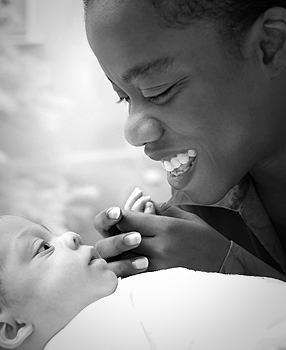SPRING 2009 CONTENTS
Home
The demonization of immunization
Shots get the once-over
What is a vaccine?
Immunization demystified
Asking How
Vaccine Side Effects Probed
When science gets hijacked
NBC News chief medical editor tells why she broke her silence
Insourced to India
A vaccine for a scourge of the developing world
Peet’s passion
The medical education of Amanda Peet
Field yields
Can genetically engineered plants provide vaccines?
Shoot it, donít smoke it
An injectable tobacco-grown vaccine
Golden needles
Vaccines for seniors
Grow up
Can vaccines built for kids work in older immune systems too?


Double trouble
Rare back-to-back surgery ends well
By Erin Digitale
Photograph courtesy of Lucile Packard Children’s Hospital
Michelle Mattingly’s liver was failing so fast, her doctors thought the baby she was carrying — still 14 weeks before his due date — was doomed.
“We were thinking we’d be lucky to get one live person out of this situation, and we didn’t know which it would be,” says William Benitz, MD, chief of neonatology at Lucile Packard Children’s Hospital.
The crisis began Aug. 3, 2008, with Mattingly nauseated and in pain. She and her husband came to Packard Children’s to make sure their unborn son was OK. While monitoring the mother, the labor and delivery staff detected an alarming spike in her blood indicators of liver failure. They rushed her next door to the adult intensive care unit at Stanford Hospital.
Over the next several hours, her liver stopped filtering toxins from her bloodstream. The toxic buildup in her blood caused her to slip into a coma on the evening of Aug. 4. As she grew sicker, Stanford’s adult liver transplantation team evaluated her case, consulted with her husband and decided against an immediate cesarean.
“With the mother in that condition, she would have died, no question,” says Carlos Esquivel, MD, PhD, chief of the division of transplantation surgery at Packard Children’s and Stanford. “Patients in liver failure cannot tolerate the stress of surgery.” The liver makes blood-clotting factors, and Michelle’s clotting-factor levels were so low that her risk of bleeding to death during surgery was extreme. With her pregnancy just six months along, an immediate cesarean risked the baby’s life too.
The doctors stabilized her and waited for a donor liver, placing her on the national list for an urgent transplant Aug. 5. They gave her steroids to help the baby’s lungs mature and transfused blood to reduce her levels of blood toxins and raise her clotting-factor levels. They had to find a donor organ before Mattingly died or suffered permanent brain damage from the toxins in her blood.
“They told us we had 72 hours to get her a new liver,” says her husband, Leonard Mattingly, a petty officer second class with the U.S. Navy, stationed in Sunnyvale, Calif.
Over the next few days, the transplant team had to reject two donor livers. The first did not match her immune system; the second contained cancerous cells. Finally, with time running out, a third liver became available.
The organ matched. At 11:03 a.m. Aug. 8, Stanford’s high-risk obstetrics team delivered John, who was rushed to the neonatal intensive care unit at Packard. Esquivel’s transplant team immediately began operating to give his mother a new liver. The transplant worked.
“To end up with the mom and child surviving all this is unbelievable,” says Esquivel.
After the operation, Michelle Mattingly spent about a month in the hospital, gradually regaining awareness and healing from her surgeries, the cause of her liver failure still a mystery. As a preemie, John stayed nearly three months at Packard Children’s before moving home with his parents and sister.
The mother is taking it in stride. “When I was told what happened, I thought, OK, it’s done,” she says. “I wasn’t mad or angry. I just thought, what am I supposed to learn from this? What can I teach someone else?” And her husband has a new appreciation for organ donation. “You don’t realize what it means until you see it in action,” he says.

